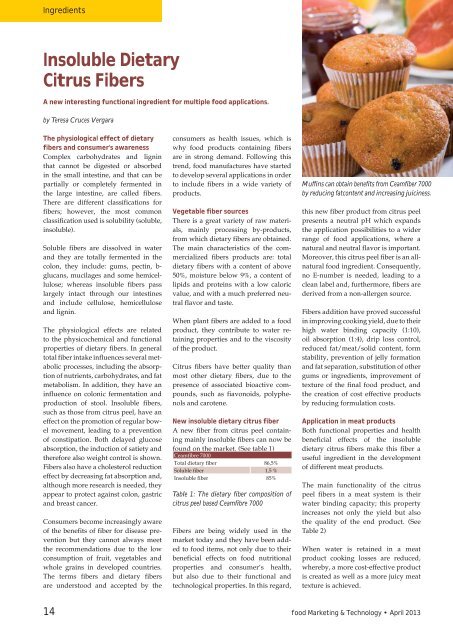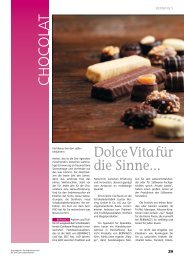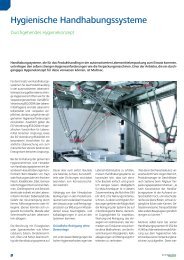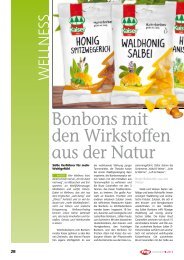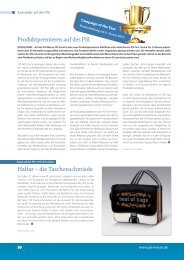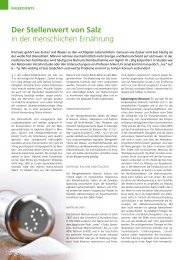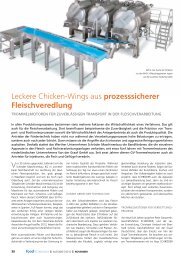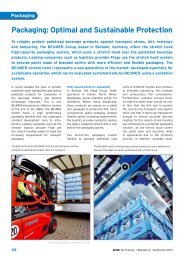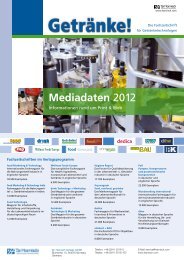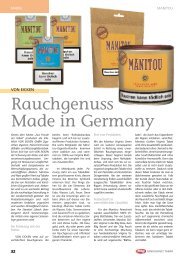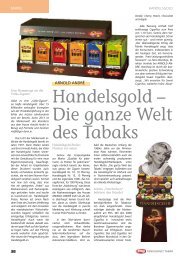Create successful ePaper yourself
Turn your PDF publications into a flip-book with our unique Google optimized e-Paper software.
Ingredients<br />
Insoluble Dietary<br />
Citrus Fibers<br />
A new interesting functional ingredient for multiple food applications.<br />
by Teresa Cruces Vergara<br />
The physiological effect of dietary<br />
fibers and consumer’s awareness<br />
Complex carbohydrates and lignin<br />
that cannot be digested or absorbed<br />
in the small intestine, and that can be<br />
partially or completely fermented in<br />
the large intestine, are called fibers.<br />
There are different classifications for<br />
fibers; however, the most common<br />
classification used is solubility (soluble,<br />
insoluble).<br />
Soluble fibers are dissolved in water<br />
and they are totally fermented in the<br />
colon, they include: gums, pectin, b-<br />
glucans, mucilages and some hemicellulose;<br />
whereas insoluble fibers pass<br />
largely intact through our intestines<br />
and include cellulose, hemicellulose<br />
and lignin.<br />
The physiological effects are related<br />
to the physicochemical and functional<br />
properties of dietary fibers. In general<br />
total fiber intake influences several metabolic<br />
processes, including the absorption<br />
of nutrients, carbohydrates, and fat<br />
metabolism. In addition, they have an<br />
influence on colonic fermentation and<br />
production of stool. Insoluble fibers,<br />
such as those from citrus peel, have an<br />
effect on the promotion of regular bowel<br />
movement, leading to a prevention<br />
of constipation. Both delayed glucose<br />
absorption, the induction of satiety and<br />
therefore also weight control is shown.<br />
Fibers also have a cholesterol reduction<br />
effect by decreasing fat absorption and,<br />
although more research is needed, they<br />
appear to protect against colon, gastric<br />
and breast cancer.<br />
Consumers become increasingly aware<br />
of the benefits of fiber for disease prevention<br />
but they cannot always meet<br />
the recommendations due to the low<br />
consumption of fruit, vegetables and<br />
whole grains in developed countries.<br />
The terms fibers and dietary fibers<br />
are understood and accepted by the<br />
consumers as health issues, which is<br />
why food products containing fibers<br />
are in strong demand. Following this<br />
trend, food manufactures have started<br />
to develop several applications in order<br />
to include fibers in a wide variety of<br />
products.<br />
Vegetable fiber sources<br />
There is a great variety of raw materials,<br />
mainly processing by-products,<br />
from which dietary fibers are obtained.<br />
The main characteristics of the commercialized<br />
fibers products are: total<br />
dietary fibers with a content of above<br />
50%, moisture below 9%, a content of<br />
lipids and proteins with a low caloric<br />
value, and with a much preferred neutral<br />
flavor and taste.<br />
When plant fibers are added to a food<br />
product, they contribute to water retaining<br />
properties and to the viscosity<br />
of the product.<br />
Citrus fibers have better quality than<br />
most other dietary fibers, due to the<br />
presence of associated bioactive compounds,<br />
such as fiavonoids, polyphenols<br />
and carotene.<br />
New insoluble dietary citrus fiber<br />
A new fiber from citrus peel containing<br />
mainly insoluble fibers can now be<br />
found on the market. (See table 1)<br />
Ceamfibre 7000<br />
Total dietary fiber 86,5%<br />
Soluble fiber 1,5 %<br />
Insoluble fiber 85%<br />
Table 1: The dietary fiber composition of<br />
citrus peel based Ceamfibre 7000<br />
Fibers are being widely used in the<br />
market today and they have been added<br />
to food items, not only due to their<br />
beneficial effects on food nutritional<br />
properties and consumer’s health,<br />
but also due to their functional and<br />
technological properties. In this regard,<br />
Muffins can obtain benefits from Ceamfiber 7000<br />
by reducing fatcontent and increasing juiciness.<br />
this new fiber product from citrus peel<br />
presents a neutral pH which expands<br />
the application possibilities to a wider<br />
range of food applications, where a<br />
natural and neutral flavor is important.<br />
Moreover, this citrus peel fiber is an allnatural<br />
food ingredient. Consequently,<br />
no E-number is needed, leading to a<br />
clean label and, furthermore, fibers are<br />
derived from a non-allergen source.<br />
Fibers addition have proved successful<br />
in improving cooking yield, due to their<br />
high water binding capacity (1:10),<br />
oil absorption (1:4), drip loss control,<br />
reduced fat/meat/solid content, form<br />
stability, prevention of jelly formation<br />
and fat separation, substitution of other<br />
gums or ingredients, improvement of<br />
texture of the final food product, and<br />
the creation of cost effective products<br />
by reducing formulation costs.<br />
Application in meat products<br />
Both functional properties and health<br />
beneficial effects of the insoluble<br />
dietary citrus fibers make this fiber a<br />
useful ingredient in the development<br />
of different meat products.<br />
The main functionality of the citrus<br />
peel fibers in a meat system is their<br />
water binding capacity; this property<br />
increases not only the yield but also<br />
the quality of the end product. (See<br />
Table 2)<br />
When water is retained in a meat<br />
product cooking losses are reduced,<br />
whereby, a more cost-effective product<br />
is created as well as a more juicy meat<br />
texture is achieved.<br />
14<br />
food Marketing & Technology • April 2013
Ingredients<br />
% Syneresis of cooked and sliced ham<br />
after 1 week´s storage and stress test<br />
REF with no Ceamfibre 7000 9,6%<br />
With 0,8% Ceamfibre 7000 6,4%<br />
Table 2:<br />
Applying Ceamfibre<br />
7000 in meat<br />
products improves<br />
water holding and<br />
juiciness<br />
Figure 1:<br />
Restructured ham<br />
with 1% Ceamfibre<br />
7000<br />
Figure 2: Extended MDM 1:50:50 (1 part Ceamgel 1320 with<br />
Ceamfibre 7000, 50 parts MDM and 50 parts water)<br />
Extension of MDM meat by applying insoluble citrus fiber<br />
When meat is to be extended it is important to retain the<br />
added water and, at the same time, maintain the meat texture<br />
and eating quality. Fibers help to both texturize and<br />
bind water in the meat system due to the porosity of the fiber<br />
structure. By hydrating the fibers with water, the water occupies<br />
the fiber pores, contributing to its texture.<br />
An interesting characteristic of insoluble citrus peel fibers is<br />
its capacity to improve MDM (mechanically deboned meat)<br />
so that the MDM can be applied in higher doses and/or with<br />
improved results in meat blends. (See Figure 2)<br />
Citrus fibers increase the viscosity of the MDM meat mixture,<br />
which improves its processability. They also contribute to the<br />
improvement of the meat cohesiveness, leading to an eating<br />
Figure 3: Ceamfibre<br />
7000 improving<br />
texture and eating<br />
quality of sausages<br />
(Left=control,<br />
right= 1,5%<br />
Ceamfibre 7000)<br />
AVEBE, your dairy partner!<br />
Looking for great texture in<br />
dairy products?<br />
At AVEBE, we innovate to solve customers’<br />
challenges.<br />
Our product lines include ingredient solutions<br />
for enhancing visual appeal and creaminess<br />
with reduced fat, all at lower cost!<br />
Get more details now to make your products<br />
stand out!<br />
Contact us at Dairy@AVEBE.COM<br />
P.O. Box 15 | 9640 AA Veendam |<br />
The Netherlands<br />
WWW.AVEBE.COM<br />
Key No. 80581<br />
food Marketing & Technology • April 2013<br />
15
Ingredients<br />
Syneresis %<br />
Control, Standard meat brine. 4,55<br />
Brine with 2% Ceamfibre 2,51<br />
Brine with 2% potato starch 2,91<br />
Table 3: Reduction of syneresis in pork ham<br />
with Ceamfibre 7000 compared to standard<br />
brine and to brine with potato starch added.<br />
quality comparable to traditional meat<br />
products without MDM added.<br />
Another important characteristic of citrus<br />
fibers is their capacity to maintain<br />
the original texture of the meat product<br />
once it has been heated. Since the fibers<br />
do not melt at high temperatures, they<br />
maintain their structure and their water<br />
retaining ability, which contributes to<br />
the improvement of the texture. (See<br />
Figure 3)<br />
Soy protein replacement<br />
Soy protein is used for emulsification<br />
and texturizing purposes. Soy isolates<br />
are mainly used to improve the texture<br />
of meat products, but are also used to<br />
increase protein content and to enhance<br />
moisture retention and emulsification.<br />
Nevertheless, soy protein can present<br />
some disadvantages that can be solved<br />
by substituting soy protein with citrus<br />
peel insoluble fibers. Some of these disadvantages<br />
when using soy protein are<br />
the lack of GMO free status (Genetically<br />
modified organisms) and the presence<br />
of allergens. Apart from the economic<br />
benefits when using citrus peel fibers,<br />
they provide a clean label and the warranty<br />
of a non-allergen origin.<br />
Replacement of starch with<br />
insoluble dietary citrus fiber<br />
Regarding the use of starch in meat<br />
products, insoluble dietary citrus fibers<br />
can eliminate some of the disadvantages<br />
of starch such as retrogradation<br />
(crystallization), undesirable viscosity<br />
creation and syneresis. In addition, the<br />
Ingredients %<br />
Oil 65,00<br />
Water 20,80<br />
Ceamfibre 7000SF 1.00<br />
Egg white 4,00<br />
Egg yolk 5,00<br />
Salt 1,00<br />
Sugar 0,50<br />
Potassium sorbate 0,20<br />
Vinegar 2,50<br />
TOTAL 100,00<br />
Table 4: Clean label mayonnaise with<br />
Ceamfibre 7000SF<br />
Photos & Tables: Ceamsa<br />
use of starch is limited in some countries<br />
due to their legislation. When the<br />
goal is to reduce syneresis, fibers thus<br />
can be a perfect substitute. (See Table 3)<br />
Insoluble dietary citrus fiber used in<br />
mayonnaise, ketchup and salsas<br />
Mayonnaise has demonstrated to be<br />
an interesting application for insoluble<br />
citrus peel fibers. The use of citrus<br />
fibers can lead to the total or partial<br />
substitution of expensive gums, such<br />
as xanthan and guar. Moreover, since<br />
fibers are an ingredient and not a food<br />
additive, we are able to obtain “clean<br />
label” products, fulfilling the needs of<br />
the most health-conscious consumers.<br />
(See Table 4 and 5)<br />
The use of fibers can also optimize the<br />
ingredient composition of a “light”<br />
product reducing significantly its fat<br />
content. This is interesting not only<br />
from a health point of view, but also<br />
from an economic stand point. When<br />
developing these challenging products,<br />
it is very important to maintain the<br />
organoleptic quality when a low fat<br />
containing product is compared to its<br />
high-fat counterpart. Insoluble citrus<br />
peel fiber, thanks to its water-binding<br />
capacity, increased viscosity and the<br />
neutral flavor, solves this important<br />
issue.<br />
Figure 5: Increased volume with Ceamfibre 7000F. Left: Cake with 4% Ceamfibre 7000F+ 4.4%<br />
water Middle: Cake with 4% Ceamfibre 7000F Right: Reference without Ceamfibre 7000F.<br />
Ingredients %<br />
Water 55,96<br />
Oil 23,62<br />
Vinegar 3,77<br />
Salt 3,31<br />
Sugar 5,68<br />
Egg 1,39<br />
Xanthan 0,3<br />
Guar 0,2<br />
Starch 3,77<br />
Ceamfibre 7000SF 2,00%<br />
Table 5: When applying Ceamfibre 7000SF in<br />
low fat mayonnaise the level of guar/xanthan<br />
can be reduced considerably.<br />
In the manufacture of ketchup and<br />
salsa, insoluble dietary citrus fibers can<br />
likewise substitute other gums or solids<br />
and support excellent eating quality.<br />
Applications in processed cheese<br />
Insoluble dietary citrus fibers also has<br />
a place in the cheese industry, where<br />
they will help to reduce syneresis and<br />
cost, by decreasing the amount of dry<br />
extract, or diminishing the use of more<br />
expensive gums, such as Locust bean<br />
gum. Equally important is the fact,<br />
that the fibers will provide a desired<br />
increased hot viscosity, which is important<br />
in the cheese process in terms<br />
of avoiding problems with splattering<br />
and work safety.<br />
Insoluble dietary citrus fiber used in<br />
bakery products<br />
During the past decades, the industry<br />
has mainly been focusing on a variety<br />
of bakery products, where almost<br />
exclusively refined flour was used,<br />
and from which the bran, germ and<br />
endosperm were stripped away. Nevertheless,<br />
a new trend has lately been<br />
developed, where both whole-grain<br />
products and fibers as ingredient are<br />
becoming increasingly demanded.<br />
In muffins and cake-type products fibers<br />
are added in order to acquire functional<br />
properties to improve texture,<br />
shrink control or volume. (See Figure 5)<br />
Due to the water binding capacity of<br />
the citrus peel fibers, they can replace<br />
up to 50% of the fat content without<br />
recognizing any change in the palatability,<br />
and, in some cases, they can<br />
even improve the moistness.<br />
food Marketing & Technology
Ingredients<br />
Figure 7: Baking stability of Jams. After 10 min at 200 ºC.<br />
Left: Jam with 0,15% Ceamfibre 7000 added. Right: Reference without Ceamfibre 7000.<br />
Bakery jams and fruit preparations<br />
The baking stability in jams is a very<br />
important attribute when jam is added<br />
to bakery products in order to maintain<br />
the texture and prevent jams from being<br />
burnt during the process. Regarding<br />
this attribute, a protective effect against<br />
heat damage has been observed with<br />
just a little amount of Citrus peel fiber<br />
addition. (See Figure 7) The addition of<br />
insoluble citrus fiber in fruit prepara-<br />
tions for yoghurt has also shown to<br />
improve texture and consistency. The<br />
fiber can optimize the cost of the fruit<br />
preparation as well as partial substituting<br />
fruit solids, starch and/or guar,<br />
and still preserve perfectly the mouth<br />
feel of the preparation.<br />
Conclusion:<br />
The advantages of using insoluble dietary<br />
citrus fibers are multiple and relevant<br />
in a wide range of food products.<br />
Main benefits are their water retaining<br />
capacity, and their cost-effectiveness by<br />
replacing ingredients/ solids or substituting<br />
more expensive gums, as well as<br />
its contribution to a “clean label”.<br />
In addition, and because of its high<br />
versatility, insoluble citrus fibers can<br />
help consumers to meet the health<br />
recommendations of dietary fiber<br />
reducing the high deficit existing in its<br />
consumption.<br />
Key No. 81334<br />
The Author<br />
Teresa Cruces Vergara is Food Scientist<br />
w ith the R&D department of Ceamsa in<br />
Porriño, Spain.<br />
EC Lactic Acid Approval<br />
Will Improve Food Safety<br />
One of the global leader in food preservation,<br />
has welcomed the European<br />
Commission’s approval of the use of<br />
lactic acid as a decontaminant for beef<br />
carcasses, half carcasses and quarters.<br />
Already widely used to reduce microbial<br />
surface contamination in the USA<br />
for some time, the use of lactic acid for<br />
this purpose in beef has been permitted<br />
in Europe since 25 February. The decision<br />
will boost food safety for consumers,<br />
according to the company.<br />
“This regulation is great news for the<br />
European beef industry,” said Lonneke<br />
van Dijk, category manager meat at<br />
Purac. “Treating beef with a lactic acid<br />
wash has proven effective in reducing<br />
foodborne pathogens and will be a<br />
valuable additional aspect of HACCP<br />
practices in slaughterhouses, providing<br />
the European meat industry another<br />
effective solution to fight various foodborne<br />
pathogens, including E-coli and<br />
Salmonella. This, in turn, will ensure<br />
higher food safety standards and prolong<br />
shelf life.”<br />
The company stressed that the use of<br />
lactic acid is an additional tool in the<br />
food safety armoury, not a substitute<br />
for hygienic practice.<br />
Lactic acid and its derivatives have<br />
been used as natural antimicrobial<br />
agents in many parts of the food industry<br />
for years, so have a long history of<br />
safe use. Purac’s portfolio has formed<br />
part of multiple hurdle food safety<br />
programmes in the meat industry for<br />
several decades, and the company now<br />
holds sector expertise and technical<br />
insight to help slaughterhouses and<br />
processors maximize the safety, shelf<br />
life and appeal of their products.<br />
The use of lactic acid for surface decontamination<br />
in beef slaughterhouses was<br />
deemed safe by EFSA (the European<br />
Food Safety Authority) in 2011.<br />
Key No. 81362<br />
Photos: Purac<br />
18<br />
food Marketing & Technology • April 2013


